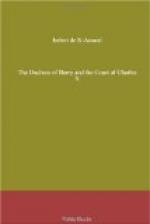M. de Vaulabelle makes this curious comparison:—
“Behind Charles X. there knelt his Grand Chamberlain, Prince Talleyrand, covered with gleaming embroideries, orders, and cordons. It was the ecclesiastical dignitary whom Paris had beheld celebrating the Mass of the Federation on the Champ-de-Mars, the wedded prelate who, as Minister of the Directory, had for some years observed as a national festival the anniversary of this same execution, now the subject of so many tears.”
Religious people rejoiced at the ceremony that was celebrated; but the Voltairians and the enemies of royalty complained bitterly at the sight of the quays, the streets, the squares of the capital furrowed by long files of priests, chanting psalms and litanies, dragging devout in their suite the King, the two Chambers, the judiciary, the administration, and the army. Yet was it not just that Charles X. should cause an expiatory ceremony to be celebrated at the place where his unfortunate brother had been guillotined? Was not that for a pious sovereign the accomplishment of a sacred duty? It matters not; there were those who reproached him with this homage to the most memorable of misfortunes. They would have forbidden to Charles X. the memory of Louis XVI. Yet a king could hardly be asked to have the sentiments of a conventionnel, of a regicide. In their systematic and bitter opposition, the adversaries of the Restoration imputed to the royal family as a crime its very virtues and its piety.
Charles X. was not unaware of this half-expressed hostility. That evening he wrote to M. Villele, President of the Council of Ministers:—
“In general I have been content with the ceremony and the appearance of the people; but I wish to know the whole truth, and I charge you to see M. Delavau, and to know from him if the reality corresponds to appearances, if there was any talk against the government and the clergy. I wish to know all, and I trust to you to leave me in ignorance of nothing.”
M. de Villele was not a flatterer. He responded discreetly, but without concealing the truth:—
“The aspect of the people,” he wrote, “permitted the thoughts agitating its spirit to be recognized. We were following the King at a slight distance and could judge very well of it. It was easy to read in all eyes that the people were hurt at seeing the King humbly following the priests. There was in that not so much irreligion as jealousy and animosity toward the role played by the clergy.”
It might have been asked, in these circumstances, whether the criticisms of the opposition were just. If a ceremony was to be observed, such, as the laying and blessing the corner-stone of an expiatory monument, it must be religious. If it were religious, was not the presence of the clergy in large numbers natural?




